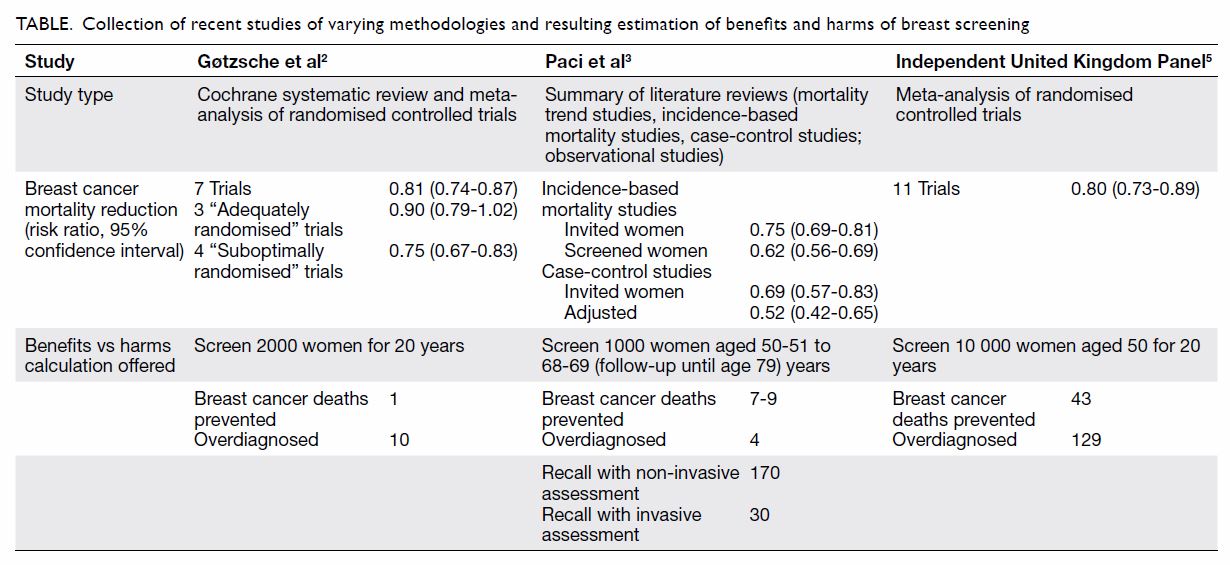DOI: 10.12809/hkmj187405
© Hong Kong Academy of Medicine. CC BY-NC-ND 4.0
LETTER TO THE EDITOR
Breast screening controversy and the ‘mammography
wars’—two sides to every story
Ashley Kieran Clift, BA, MB, BS
Department of Surgery and Cancer, Imperial College
London, United Kingdom
Corresponding author: Dr Ashley Kieran Clift (ashley.k.clift@gmail.com)
To the Editor—Whilst the emphasis on shared
decision making in breast screening of Sitt et al1
is warmly welcomed, one struggles to visualise how this can be promoted
when their overview could arguably be condensed into three major take-home
messages: (1) any study critical of screening is ‘controversial’; (2)
risks of screening are overstated; and (3) harms of not screening are
overestimated.
The “mammography wars” are predicated by the
multiple ways one may analyse mammography screening studies. Estimates of
the harms versus benefit “balance sheet” vary wildly depending on the
approach utilised (Table).2 3 Furthermore, estimates of
overdiagnosis rates can range from 0% to 54%,4
dependent on whether studies are based on modelling or cohort observation,
which denominator is used, and what adjustments are made (themselves
sometimes debated). Essentially, the body of evidence can be “tortured” to
give almost any answer you desire. Surely no other topic in medicine can
show so many ways to slice the same cake?

Table. Collection of recent studies of varying methodologies and resulting estimation of benefits and harms of breast screening
The most ardent supporter and passionate dissident
can agree that breast screening is imperfect—arguably favourable to
suppressing any component of the debate is providing a balanced view. This
does not need to constitute a conciliatory back-of-the-envelope
calculation—this ‘third way’ could manifest as the (importantly)
independent United Kingdom panel report5
which calculated that screening 233 women for 20 years can prevent one
death, but three women will be overdiagnosed and overtreated.
Only when Hong Kongers are fully informed of the
potential benefits and harms can they make truly informed choices.
Declaration
The author has no conflicts of interest to declare.
The author had full access to the data, contributed to the study, approved
the final version for publication, and takes responsibility for its
accuracy and integrity.
References
1. Sitt JC, Lui CY, Sinn LH, Fong JC.
Understanding breast cancer screening—past, present, and future. Hong Kong
Med J 2018;24:166-74. Crossref
2. Gøtzsche PC, Jørgensen KJ. Screening for
breast cancer with mammography. Cochrane Database Syst Rev
2013;(6):CD001877. Crossref
3. Paci E, Broeders M, Hofvind S, Puliti D,
Duffy SW, EUROSCREEN Working Group. European breast cancer service
screening outcomes: a first balance sheet of the benefits and harms.
Cancer Epidemiol Biomarkers Prev 2014;23:1159-63. Crossref
4. Løberg M, Lousdal ML, Bretthauer M,
Kalager M. Benefits and harms of mammography screening. Breast Cancer Res
2015;17:63. Crossref
5. Independent UK Panel on Breast Cancer
Screening. The benefits and harms of breast cancer screening: an
independent review. Lancet 2012;380:1778-86. Crossref

